Commemorating the Serviceof
|
 |
Herbert Good
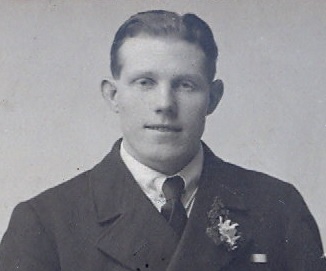
Royal Navy
Notes:
- This page is under development and was first
published for Remembrance Day 2018
- In this revision on 10 Nov 2019, we have added a
link to a description of the actions of HMS Malaya and
the service of Herbert on that ship during the period
1936 - 39.
Herbert's Childhood
Herbert
was born 7 June 1895 in Gosport, [source
naval and census records] the son of Edmund and Kate
Alice Good who were butchers. His father was a third
generation butcher whose father, Edmund Good,
grandfather, Edmund Good, and great-grandfather William Good were all butchers,
William Good also being a cattle dealer.
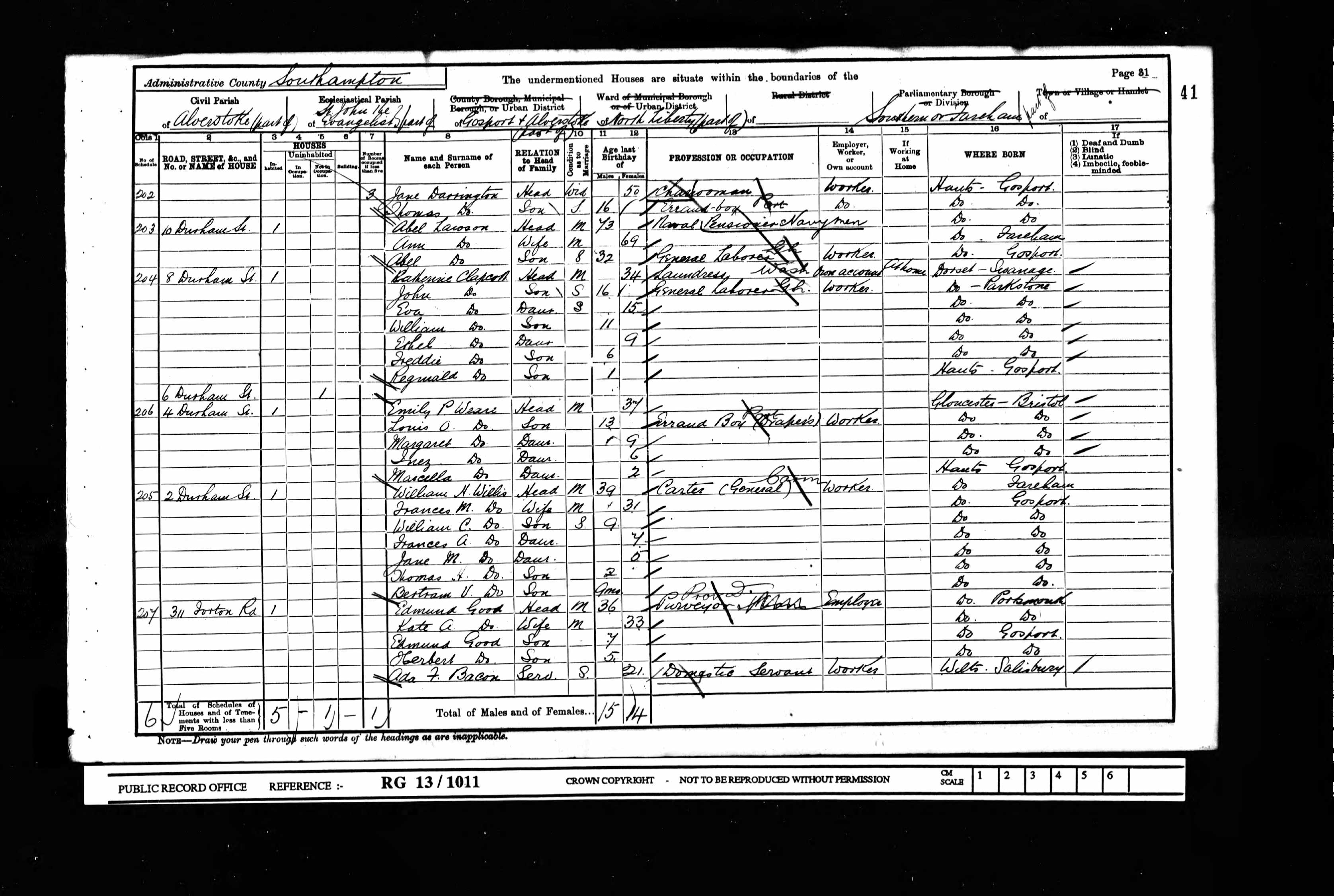 |
| Herbert is a 5 year old boy
living at 311 Forton Rd. Gosport. The
occupation of Edmund's father (purveyor) is not clear from the entry, but he is an employer. From family knowledge we know he was a butcher. The mother is named Kate. Herbert has a brother, Edmund, 2 years older than he. The census address of 311 Forton Road is likely incorrect -- it should be 310 Forton Road [source: Carole Jarmon, grand niece]. The building currently at 310 is of relatively new construction. |
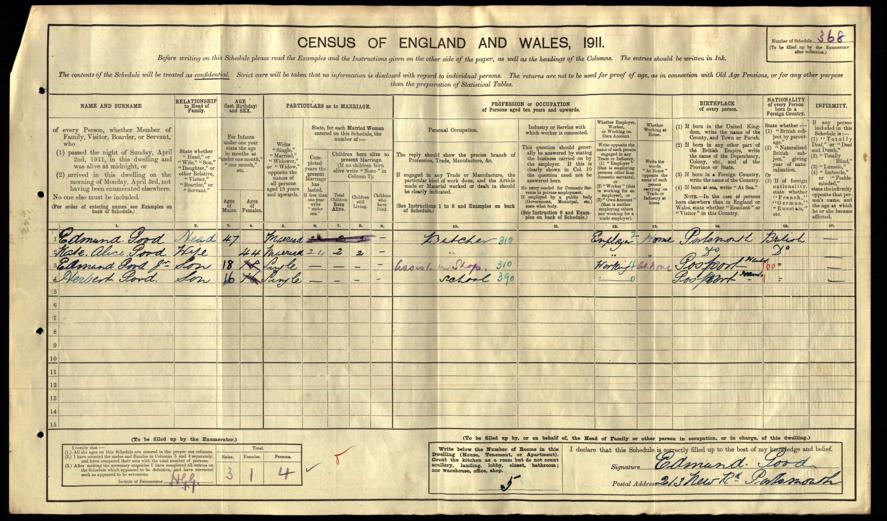 |
| Herbert
is shown as a 16 year old who is at school. |
By 1911 Herbert's father has relocated his business to 213 New Rd. in Portsmouth. Herbert's older brother Edmund is working in the butcher shop, while Herbert is still at school. The address still exists and looks to be a building that dates from that time. It is currently a bicycle repair shop. It would be interesting to know why the business location was changed. Perhaps it was inherited from Edmund's father (I do not know when he died, of if he owned the property -- the GOOD family owned various properties in Portsmouth in earlier generations). Perhaps Edmund also kept the location in Gosport.
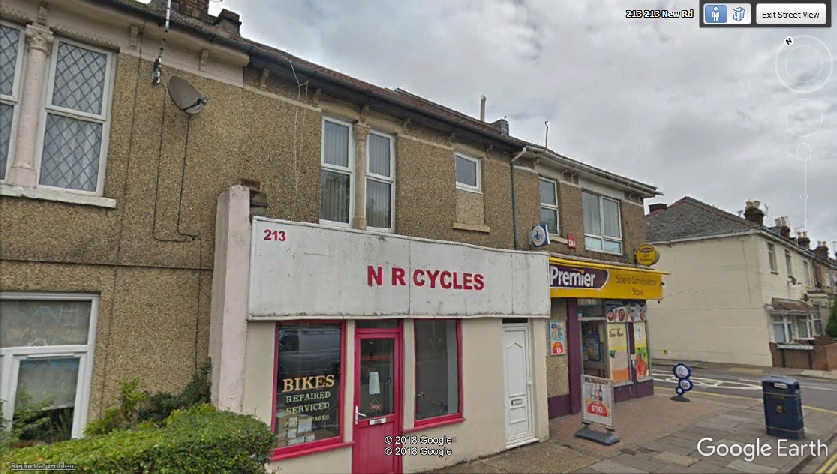 |
| 213 New Road, Portsmouth, today |
Military Service
At this time we do not have the personnel records of
Herbert's service in the Royal Navy. We do, however,
have a record of the ships and establishments he served
with during his career as well as the promotions that he
received during that time, as shown below. These records
relate particularly to where he was serving and when he
was promoted for purposes of ensuring that he was
accordingly paid.
The Early Naval Service
On 8 August 1911, at the age of 16 Hervert joined the
Royal Navy (RN) as a boy artificer. When he turned 18 on
7June 1913 he enlisted in the Royal Navy for an initial
commitment of 12 years. That was a common enrollment at
that time in the armed forces of the United Kingdom. He
served continuously in the RN until his retirement,
until after WWII. Had it not been for WWII he would
likely have retired at an earlier age, but with the war
his service was extended 'for the duration'.
Engine
Room Artificers and Electrical Artificers were some of
the most highly skilled and well-paid enlisted men in
the Navy. They were selected upon entering the service
to receive several years of training ashore in the
naval dockyards before being assigned to vessels.
Chief Engine Room Artificers and Chief Electrical
Artificers ranked above most other chief petty
officers and wore three buttons on the cuffs, similar
to warrant officers. They did not wear any
distinguishing badges, except for a cap badge with a
purple background (see above). Engine Room and
Electrical Artificers (rated 1st through 4th class)
also ranked as chief petty officers, and wore Class I
uniform without specialty badges as well, but with
plain cuffs.
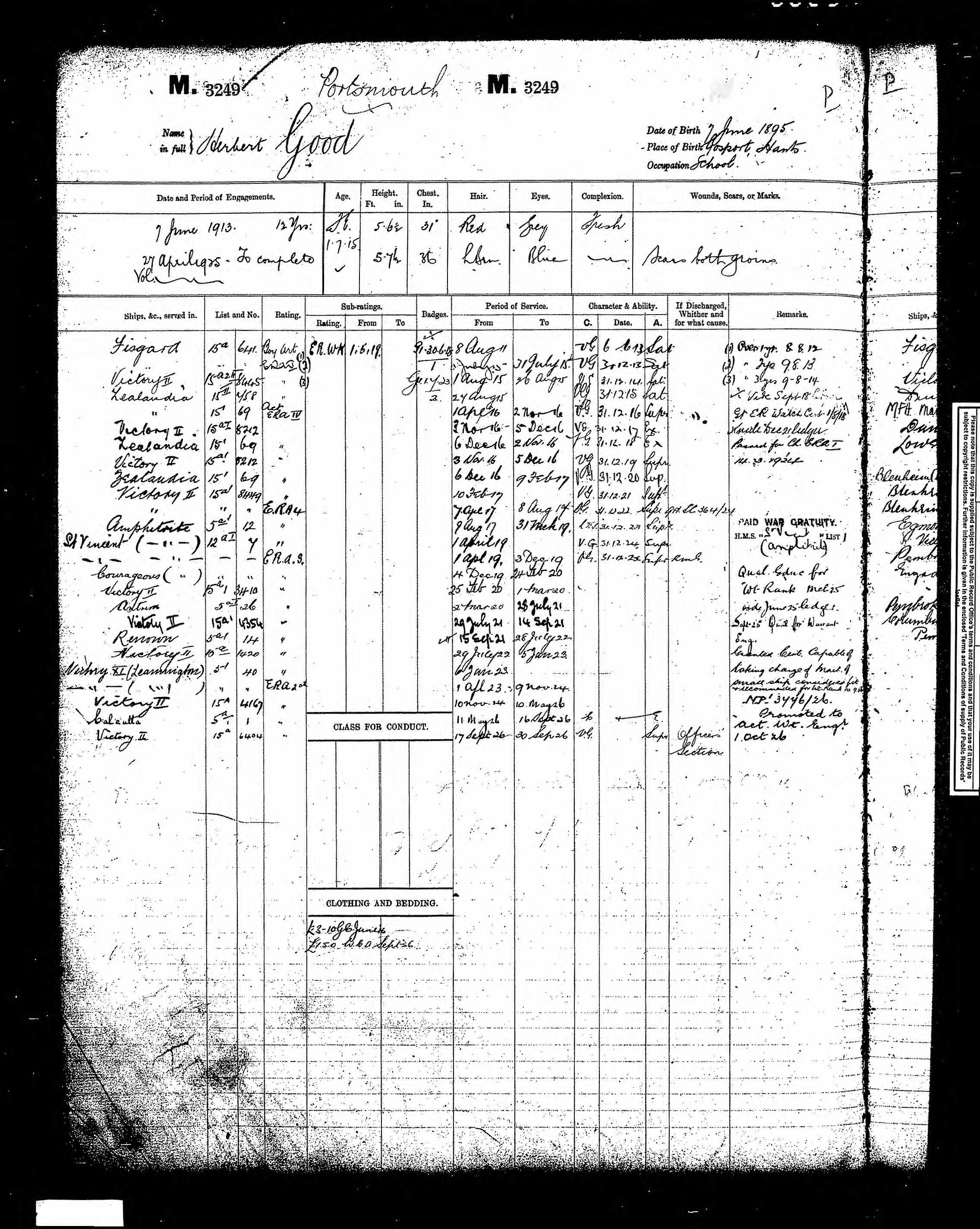 |
| Herbert's navy record for his
first 12 year enlistment. [source: ????] |
The navy record has a number of interesting facts about
Herbert and his service during this time period of 1911
- 1925.
We see that Herbert has become a boy artificer in the
RN at the age of 16, stationed at HMS Fisgard. This was
a shore establishment created to train engineering staff
to man the ships of the RN. On his 18th birthday, he
ceases to be a boy artificer and joins the navy as a
full fledged engine room artificer (E.R.A.) for an
enlistment period of 12 years.
An Engine Room Artificer (ERA) was a fitter, turner or boilermaker in the early days of steam-powered warships. Usually working under an Engineer Officer, they were able to read and write, competent in the workings of engines and boilers, and trained in the maintenance and operation and uses of all parts of marine engines. ERAs were the senior maintainers and operators of all warship mechanical plant.
We see that he is 5 ft. 6 1/2 inches, a chest of 31
inches, with red hair and grey eyes and of fresh
complexion. Interestingly no weight is recorded on this
form -- at that time virtually all people were trim and
he would probably have weighed about 120 lbs. The form
records his birth date and birth location and indicates
he has been at school -- his training at HMS Fisgard. To
be accepted into the program at HMS Fisgard would
indicate an above average mind and aptitude for
mechanical things.
The form then goes on to list his various assignments
to shore establishments and ships over the succeeding 12
years of his first enlistment. These are summarized in
the following table with comments, where possible, on
the assigments
| Ship/Establishment |
Dates |
Comments |
||
| Fisgard |
8 Aug.11 - 31 July 15 |
Shore training establishment, where
he was trained as an engine room artificer
(E.R.A.) He was training in Portsmouth at this
time. |
||
| Victory II |
1 Aug. 15 - 26 Aug. 15 |
A shore establishment often
used for pay purposes. He may have been granted
leave for this period as he had just finished his
training program as an E.R.A. |
||
| Zealandia | 26 August 1915 2 Nov 1916 |
Zealandia
was a pre-Dreadnaught class of battleship that was
initially attached to the third battle squadron of
the home fleet. On 6 Nov 1915 she was detached
from the squadron to take up service with the
Mediterranean fleet where she remained until
February 1916 when she returned to the home fleet. |
||
| Victory II |
3 Nov. 16 5 Dec. 16 |
A shore establishment often used for pay purposes. He most likely was granted leave for this period. | ||
| Zealandia | 6 Dec. 16 - 9 Feb. 17 |
Zealandia was in home waters as part of the third battle squadron. He is promoted to acting E.R.A. 4th class during this time. | ||
| Victory II | 10 Feb. 17 8 Aug. 17 |
Part of this time might have been
leave but most of it seems to have been a shore
assignment, perhaps training, as he is promoted to
full E.R.A. 4th class during this time. |
||
| Amphitrite |
9 Aug. 17 31 Mar. 19 |
Amphitrite was a minelayer.
She collided with the destroyer Nessus which sank
8 September 1918. Towards the end of this period
Herbert married May Elizabeth Beatrice Bryant on
February 19th |
||
| St. Vincent |
1 Apr. 19 3 Dec. 19 |
This was a shore training
establishment and Herbert was promoted to E.R.A.
3rd class at this time. |
||
| Courageous |
4 Dec. 19 24 Feb. 19 1920 |
Courageous
was a cruiser buily during WWI. |
||
| Victory II |
25 February 1 March |
probably a period of leave |
||
| Antrim |
2 March 1919 28 July 21 |
The ship was in
reserve by 1919, but conducted radio and Asdic trials in
1920 before becoming a training ship in 1922. During this assignment his son, Edmund was born. |
||
| Victory II | 29 July 1921 14 Sept. 1921 |
A short period ashore -- perhaps
leave or a short course |
||
| Renown |
15 Sept. 1921 28 July 1922 |
Renown |
||
| Victory II |
29 July 1922 5 Jan. 1923 |
A longer training period leading to
his promotion the following year. |
||
| Victory XI (Leamington) |
4 Jan 1923 9 Nov 1923 |
Leamington was a minelayer.
During this period he was promoted to E.R.A. 2nd
class |
||
| Victory II |
10 Nov 1924 10 Aug 1926 |
It might be that this extended
period was a training period during which time he
was being trained for officer status. It appears
he would have almost two years of training,
followed by a month on Calcutta for practical
training. |
||
| Calcutta |
11 Aug. 1926 16 Sept. 1926 |
Calcutta
was a C-Class light cruiser. |
||
| Victory II |
17 Sept. 1926 30 Sept. 1926 |
This appears to be a short training
period at which he was promoted to an Acting
Warrant Engineer, an officer's rank and his later
career is continued in the officer's section of
the records. |
.
In WWI
At the outbreak of WWI, on 4 August 1914, Herbert was a
training to become an E.R.A. This was a four year course
which he graduated from at the end of July in 1915. He
was then assigned, as an E.R.A. 4 (4th class) to the
Zealandia, a pre-dreadnaught class of battleship. This
class of ship would have many E.R.A. 4's and would give
him a position to learn his trade while having
significant supervision and instruction to bring him
from a classroom setting into an active part of the
fleet. On the Zealandia he is initially given the acting
rank of E.R.A. 4 and then, it appears, that after a
short course he returns to the Zealandia as a full
E.R.A. 4 which is the rank he attains during the war.
This rank would have given him some responsibilities at
a junior level in the engine room.
During the times that he was with the Zealandia she was
assigned to the third battle squadron of the home fleet
and also for a few months to the Mediterranean fleet.
His service in the active fleets prior to the end of
1915 entitled him to the 1914 - 15 Star. As with others
who served during the war he received the British War
Medal and the Victory Medal.
Herbert's Medals from WWI
Serving from the outbreak of war, Herbert received the standard three medals that were awarded for such service (the "Pip, Sqeak, andWilfred"), namely the
- The 1914 - 15 Star, inscribed M
3249 H. GOOD E.R.A.5 R.N. on the back, reflecting
his rating as an E.R.A. 5th class at the time of
earning the star
- the British War Medal, inscribed on the rim M
3249 H. GOOD E.R.A.4.R.N (by the end of the war he
was promoted to 4th class
- the Victory Medal, M 3249 H. GOOD E.R.A.4.R.N
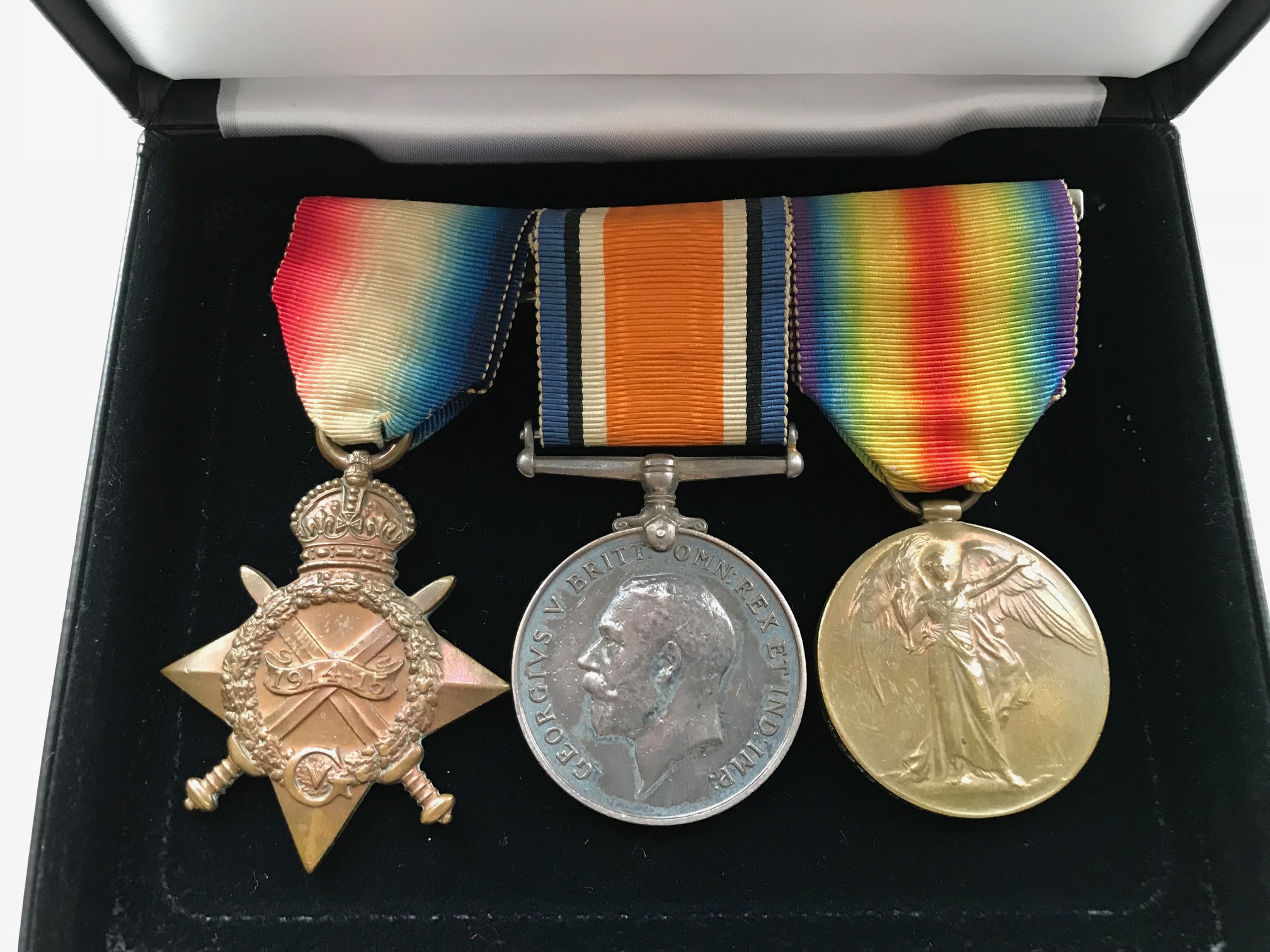 |
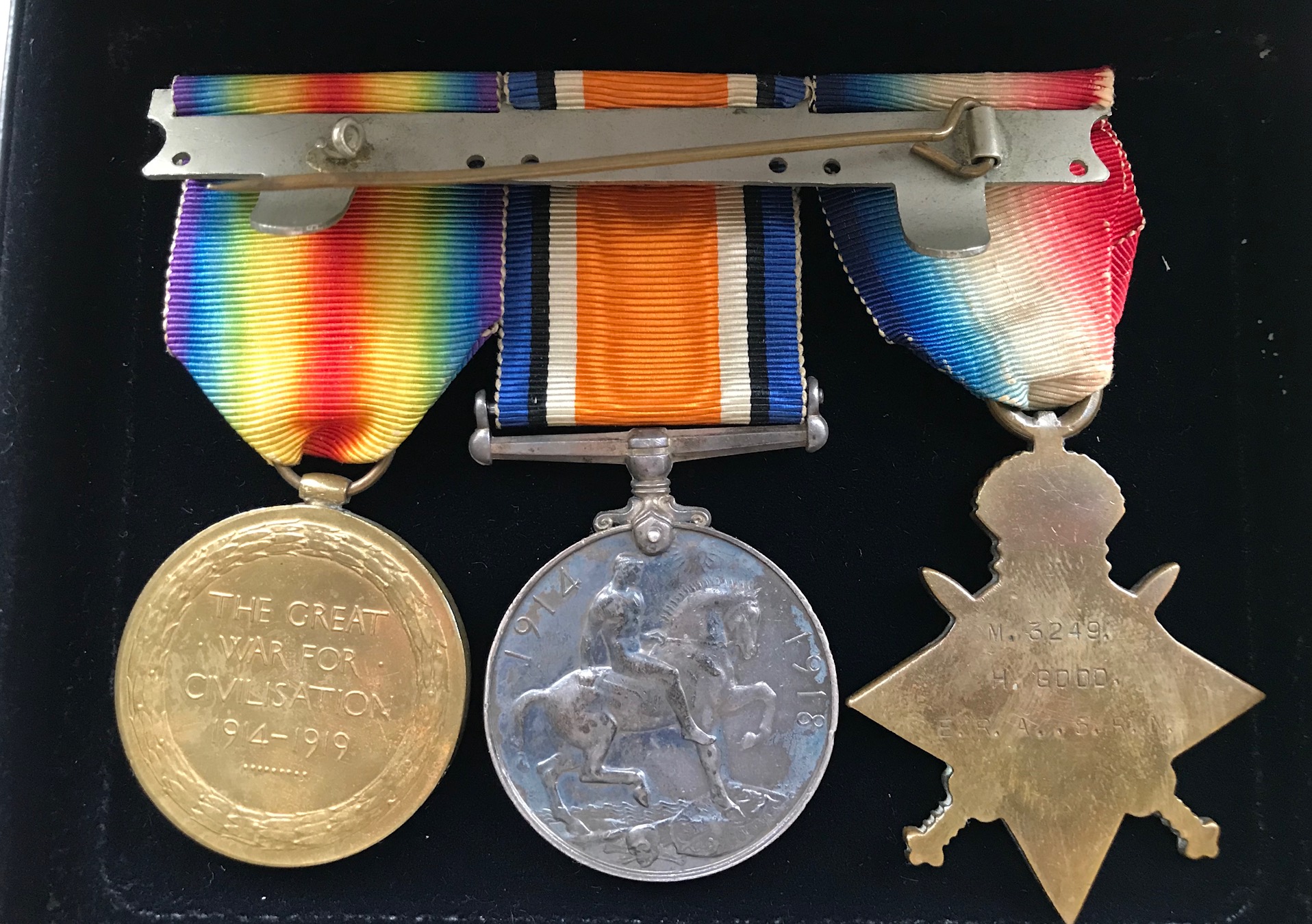 |
| WWI medals
(obverse) |
WW1 medals
(reverse) |
Later Military Service
With his promotion to officer rank, Herbert's
assignments are recorded on the officer's service pages.
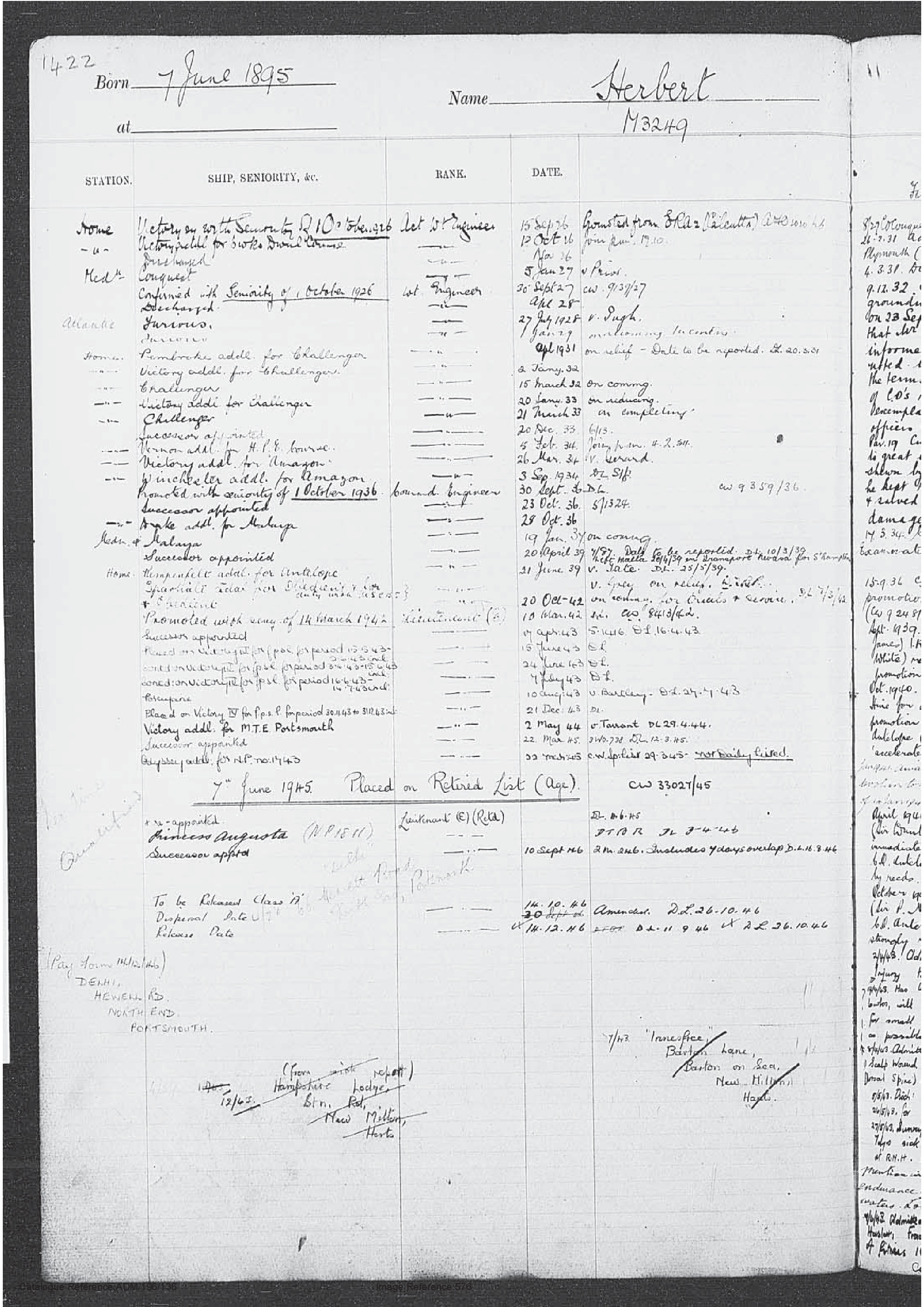
Between the Wars
promoted acting Warrant Engineer 15 Sept 1926 from E.R.A.
2 on the Calcuttain the Med from 5 Jan 1927 on the Conquest
promoted Warrant Engineer 20 Sep 1927
On the Furious from 27 July 1928
On to Challenger 15 March 1932
On to Amazon 26 Mar 1934
On Malaya 28 Oct 1936: Herbert's great granddaughter Erika has provided a description of the ship and Herbert's time on it
promoted Command Engineer 30 Sep 1936
On Antelope 21 June 1939
promoted Lieutenant (E) 14 Mar 1942
in WWII
Ships
Actions -- DSC., 1743
Medals from WWII
The medals earned by Herbert were never fully mounted as a set.The complete set, when properly mounted would be in the following order (from center of chest to shoulder):
- Member of the Order of the British Empire (Military Division)
- Distinguished Service Cross
- 1914 - 15 Star
- British War Medal
- Victory Medal
- Naval General Service Medal (with Palestine Clasp)
- 1939 - 45 Star
- Atlantic Star
- Defence Medal
- War Medal 1939 - 45 with Mentioned in Dispatches
Bronze Oak Leaf and France and Germany Clasp
These medals (as they currently exist) are shown in the above order:
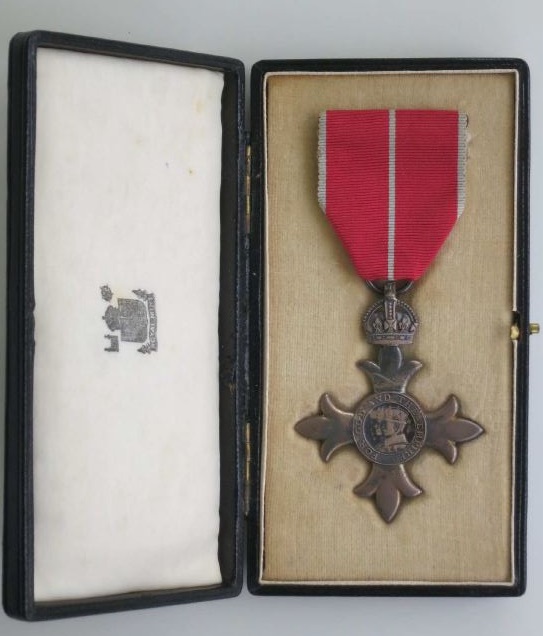 |
Member of the Order of the
British Empire (Military Division)
|
Distinguised Service Cross
(the Mentioned in Dispatches Bronze Oak Leaf
should not be worn on this medal -- see below) |
|
 |
World War I Medals:
|
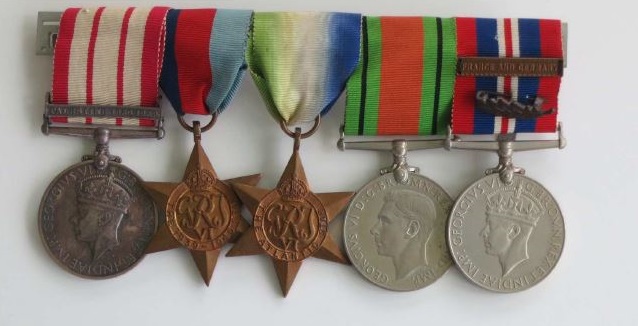 |
|
Family
Married on 2 February 1919
son Edmund born 27 August 1920
daughter Pamela birth registered in the first quarter of
1927
Retirement
Credits
- Carole Jarmon for information on the Gosport address
- Herbert's granddaughter Caroline,
her husband Alistair and great granddaughter Erika
for much of the information on Herbert's family life
and for much of the research into his naval career.
ŠKenneth Scott and others 2018
contact: ken at kenscott.com